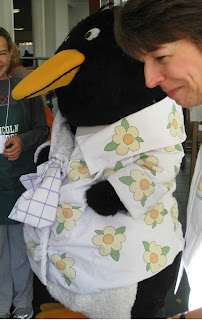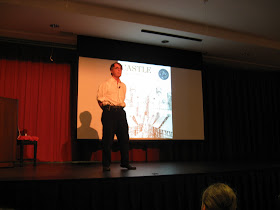It will soon be time to decide which technique I will use for my Book Dummy, and I still haven't any clue. Some days I want my story to have the sketchy look, with lots of interesting lines and patterns, and an antiqued tone to the color scheme. Other days I want the more traditional watercolor look and brighter colors... and then there are days like today where I have
no idea so I just play with my materials to see what I come up with.
I had a piece of Arches 140lb hot-pressed watercolor paper that had been coated in gesso and still taped to the board lying around my studio, so I decided to use that up. Though I don't always use it, I really enjoy looking at texture in an illustration, so this was my golden opportunity. The gesso'd paper showed lovely brush strokes and it made the paper more durable for scuffing and scrubbing.
I didn't have much of a plan, so I just sketched with my favorite blue drafting pencil, then a regular No. 2 pencil. And although I know fully well that gesso is an acrylic material, I went ahead and used a bit of brown ink wash to add some toning. It worked all right, so I thought I would test my luck and see what happened if I used watercolor.
And as we all would have guessed, not a good idea. But hey, at least I know.
To be honest, I was actually putting off using acrylic paints. They're messier than watercolors and harder to control (never thought I would say that!) because the paint can get rather blobby and it is hard to get in small details. And once they dry on the palette, there's no way of reusing the product, so it can also be wasteful. But at this point I had no choice, so I tried to pump myself up by putting on some Lady Gaga music on the Pandora channel. This helped.
I stuck with three colors: Cad Yellow Light, Cad Red Medium, and Cerulean; plus white and the inevitable black, but only because the sheep is a black sheep. I try not to use black in my art anymore, unless it is necessary.
And of course I forgot that I should have been using the Matte Medium all along, but I remembered in time before I called it quits! This stuff is relatively new to me, even though I had it with my paints for ages, I never really figured out how to use it until this year. I painted the darkest areas first, then worked my way up so I could do a bit of glazing with the lighter colors.
Then I topped it all off with Caran d'ache water soluble crayons, (I chose these because the colored pencils didn't want to work, and pastels wouldn't have either, and I don't have oil based crayons to use) and scrubbed and rubbed until it was nicely textured.
And then my least favorite characteristic of acrylics chose to show itself: lack of clean edges! I know, it's my own fault for working so messy, but I have seem to have lost some patience on that part. I cleaned them up a bit with a "shade of grey" brush-tipped pen, and I'm happy to say that it worked rather well.
In fact, I'm pretty proud of my accomplishment of the day!
Last but not least, I have a scanner comparison to share with you. The image above was scanned with a larger format scanner, the Mustek ScanExpress A3 USB 1200 Pro. The image below was scanned using an Epson V500. The Mustek is still new to me, and I am unfamiliar with the settings, but the Epson is an old friend. Because I know what settings to use, you can see more detail and texture in the Epson image. I will do more comparisons as I learn how to use the large format scanner better, so that I might be able to help someone make an educated decision when purchasing a scanner.
Thanks for reading! Have a nice week!















